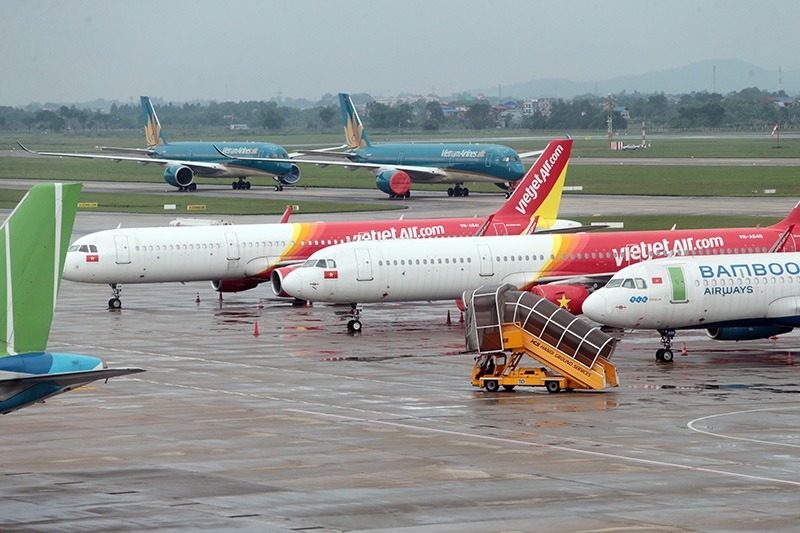Different viewpoints about building second airport for Hanoi
 |
| The viewpoint of Hanoi People’s Committee about Noi Bai International Airport planning has a stark difference with that of the transport authority |
Early this month, Hanoi People’s Committee sent Dispatch No.2146/UBND-DT to the Ministry of Transport (MoT) commenting on the planning of Noi Bai International Airport in the 2021-2030 period, with a vision towards 2050.
This is the second time in the past month the leadership of Hanoi has raised opinions to the planning of a transport system having huge impacts on the socio-economic development of not only Hanoi, but also the whole northern region.
In Dispatch 2146, Hanoi People’s Committee stressed the desire that Hanoi’s key international airport should be positioned right in the city space, with deserving role and status.
The dispatch, signed by Duong Duc Tuan, Deputy Chairman of Hanoi People’s Committee, proposed that the airport should be able to handle 130-150 million passengers a year by 2050 to match forecast development needs and orientations, instead of just 100 million passengers as mentioned in the national airport system development master planning in 2021-2030, with a vision toward 2050 outlined in Decision No.590/QD-TTg dated May 20, 2008 of the prime minister.
| According to the MoT, the consulting units have presented three scenarios on developing Noi Bai airport, corresponding to three planning schemes of Hanoi’s second airport in terms of scale, location and time of research. |
In Dispatch 2146, Hanoi People’s Committee proposed the MoT to consider two planning options for Noi Bai International Airport and the second airport for Hanoi.
Accordingly, the city’s management authority wants Noi Bai International Airport to have a scale of about 65 million passengers per year with an area of 1,493ha area, matching the airport's capacity forecast for 2030.
Hanoi’s leadership also wants the city’s second proposed international airport to be placed in Hanoi’s southern part with a capacity of 65 million passengers per year so that Hanoi's airport system can reach a total passenger annual capacity of 130 million passengers.
In case the MoT decides to raise the capacity of Noi Bai International Airport to 100 million passengers per year, Hanoi People’s Committee would still want the second airport to be able to accommodate 50 million passengers per year by 2050.
Hanoi says its proposal would allow it to prepare sufficient land area for the airport and update the relevant planning schemes.
Besides, Hanoi People’s Committee has proposed the second international airport to be placed in Ung Hoa district which has favourable transport connectivity as it is about 54km from Noi Bai International Airport and 20km northwest to Mieu Mon airport. It can easily connect with different highways such as Phap Van-Cau Gie, national highways 5 and 7A, and the North-South railway, among others.
It is also convenient for land clearance as the 1,300ha proposed space is mostly agricultural land with a low area for site clearance.
Meanwhile, in Dispatch No.6594/BGTVT-KHDT the MoT sent Hanoi People’s Committee on July 9, the ministry proposed a scale of 100 million passengers a year for Noi Bai airport while the planning of the second airport would be considered after 2030.
According to the MoT, consulting units proposed Noi Bai International Airport to have a capacity of 60-65 million passengers per year by 2030, which would be increased to 100 million passengers per year by 2050.
The MoT argued that this scheme would help optimise the airport’s financial efficiency and position advantages. It also added that Ung Hoa would be an unfeasible location for the second airport.
“Some other locations such as Thanh Mien in Hai Duong and Tien Lang in Haiphong were deemed more feasible,” said Le Anh Tuan, Deputy Minister of Transport.
According to the MoT, the consulting units have proposed postponing the study of Hanoi’s second airport to after 2040.
After receiving Hanoi People’s Committee proposal, the MoT said they would base their decision on the actual socio-economic development situation and the pace of the rebound of the local aviation market post-pandemic.
What the stars mean:
★ Poor ★ ★ Promising ★★★ Good ★★★★ Very good ★★★★★ Exceptional
Related Contents
Latest News
More News
- Can Tho utilises its growth advantages (December 15, 2025 | 09:09)
- Ca Mau unlocking potential to shape a more sustainable future (December 15, 2025 | 09:02)
- MoF workshop highlights mounting concerns over ODA on-lending costs (December 12, 2025 | 16:05)
- National Assembly approves pilot mechanisms to accelerate major projects in Hanoi (December 12, 2025 | 11:29)
- Legislation gives government flexibility for loan guarantees (December 11, 2025 | 18:04)
- Vietnam eases policy approval requirements, simplifies foreign and outbound investments (December 11, 2025 | 17:53)
- Vietnam masters core technologies of automobile value chain (December 11, 2025 | 17:46)
- VAL opens second line of largest soybean crushing complex in Southeast Asia (December 11, 2025 | 12:08)
- Vietnam urged to shore up supply-chain resilience amid global uncertainty (December 10, 2025 | 18:47)
- Unpacking new momentum in Vietnam’s M&A market (December 10, 2025 | 09:59)

 Tag:
Tag:




























 Mobile Version
Mobile Version